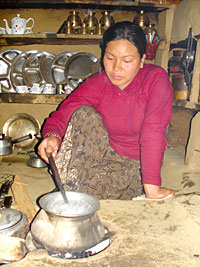 PICS: BADRI POUDYAL Ghalegaun, 2070m, is the centrepiece of the Gurung Heritage Trail |
It's not such an inconceivable task to imagine being treated like a god when you are a guest in a Nepali home! It is our tradition to treat guests in the best way possible and in keeping with this tradition, the National Trust for Nature Conservation (NTNC) and the Annapurna Conservation Area Project (ACAP) have introduced the concept of home-stay village tourism in Ghalegaun and its surrounds that takes in more than just mountains.
The 'Gurung Heritage Trail', starting from Besisahar, includes several villages of Lamjung district within the Annapurna Conservation Area, such as Ghalegaun, Ghanpokhara, Bhujung and Pasgaun. Located at an altitude of 2070 metres, Ghalegaun attracts many trekkers and tourists for home stays. Visitors are exposed to the simple life of their hosts and eat the same food - dal, rice, vegetables, roti and so on. In the evenings, the womenfolk perform song and dance routines depicting Ghantu (celebrating Lord Buddha's birthday), Sorathi, and Krishna Charitra. The guests receive a big reception on arrival as well as when they leave. But Ghalegaun also offers stunning mountain views of the Manaslu range in the east, Lamjung Himal and Annapurna II in the north, and Machapuchhare in the west.
 A traditional Gurung 'ghumaune' round-house |
Half an hour north of Ghalegaun lie two other beautiful Gurung settlements - Nayu and Ghanpokhara. Ghanpokhara is known for its honey extracted from the hives of giant wild black bees. A nice way to pass time is to seek out the 'honey hunters' so famously depicted by Eric Valli and Diane Summers in 1988. After listening to stories of their perilous adventures in the cliffs where the bees are found, you can take a two and a half hour walk to reach Bhujung.
Bhujung contains the largest Gurung population in the area, with over 400 households that pride themselves on their rich cultural heritage. They have even generated their own electricity supply, and are considered pioneers in conservation and development in the area.
After a five hour up and down hike from Bhujung you will reach a pristine village of over 200 houses called Pasgaun. Untouched by modernity, this village has retained its traditional feel, evident in its architecture (e.g. slant-roofed houses), culture, and food. With no electricity, except for those provided by solar panels, the villagers express their need for it through their evening performances.
 Typical kitchen interior |
The best time to visit these villages is from September to November, or from March to May, when the blooming rhododendrons are a sight to behold. The Tourism Management Sub Committee (TMsC) handles all the home stays in the region. Houses are solar lit, and boast toilets and bathroom facilities. Food is also provided for by the TMsC.
Five per cent of the guest's payments goes towards the committee's fund for conservation and community development, and there is also an entry fee to enter the Annapurna Conservation Area (ACA). This under-promoted tourist trail is indeed a welcome change from the Poon Hill circuit and its cousins; why not get off the beaten path and get comfortable?
READ ALSO:
The Great Himalayan Trail - FROM ISSUE #472 (16 OCT 2009 - 22 OCT 2009)
Off the beaten trek - FROM ISSUE #426 (21 NOV 2008 - 27 NOV 2008)
In the rain shadow - FROM ISSUE #308 (28 JULY 2006 - 03 AUG 2006)
The ABC of trekking - FROM ISSUE #142 (25 APRIL 2003 - 01 MAY 2003)


